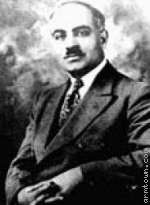By GARY J. BASS
Published: December 17, 2006
In July 1915, the American ambassador to the Ottoman Empire sent Washington a harrowing report about the Turks’ “systematic attempt to uproot peaceful Armenian populations.” He described “terrible tortures, wholesale expulsions and deportations from one end of the Empire to the other accompanied by frequent instances of rape, pillage and murder, turning into massacre.” A month later, the ambassador, Henry Morgenthau — the grandfather of the Manhattan district attorney, Robert M. Morgenthau — warned of an “attempt to exterminate a race.”
The Young Turk nationalist campaign against the empire’s Armenian subjects was far too enormous to be ignored at the time. But decades of government-backed denial have created what amounts to a taboo in Turkey today. Instead of admitting genocide, Turkish officials contend the Armenians were a dangerous fifth column that colluded with Russia in World War I; many Armenians may have died, they say, but there was no organized slaughter. Turkish writers who challenge this line, like the novelists Orhan Pamuk and Elif Shafak, have risked prosecution for insulting Turkish identity. And on the diplomatic front, when Turkey should be polishing its credentials for eventual European Union membership, it is mired in historical fights; this May, for instance, it pulled out of a NATO military exercise to protest the Canadian prime minister’s acknowledgment of the genocide.
“A Shameful Act: The Armenian Genocide and the Question of Turkish Responsibility,” by Taner Akcam, is a Turkish blast against this national denial. A historian and former leftist activist now teaching at the Center for Holocaust and Genocide Studies at the University of Minnesota, Akcam is often described as the first Turkish scholar to call the massacres genocide, and his impressive achievement here is to shine fresh light on exactly why and how the Ottoman Empire deported and slaughtered the Armenians. He directly challenges the doubters back home, basing his powerful book on Turkish sources in the old Ottoman script — including the failed Ottoman war crimes tribunals held after World War I. Although he bolsters his case with material from the American, British and German archives, he writes that the remaining Ottoman records are enough to show that the ruling party’s central committee “did deliberately attempt to destroy the Armenian population.”
Akcam closely links the 1915 genocide with World War I. The Unionists, as the nationalist leaders were known, dreaded the partition of their empire by the European great powers. Not only did they suspect the Armenians of dangerous disloyalty, Akcam writes, but massacres of Muslims in Christian regions of the faltering empire before World War I had fostered a desire for vengeance.
While never excusing the atrocities, Akcam does argue that the Turkish leaders chose genocide in a mood of stark desperation. Staggered by a series of early military defeats, and by the Allied onslaught at Gallipoli, they fully expected their empire — driven out of so much of its vast territories over the past two centuries — to collapse. The Turkish heartland of Anatolia was threatened — as was Constantinople.
The fiercest Ottoman enemy was Russia, which had nearly seized Constantinople in a bloody 1877-78 war and had a storied history of trying to foment uprisings against Ottoman rule. The Turkish nationalist line puts great weight on the internal menace of pro-Russian Armenians. But Akcam argues that there was little real danger from the Armenian uprisings, which were limited and directed mostly against the deportations. (British officials considered the Armenians militarily useless and thus refused to encourage the uprisings.) Akcam allows that the evacuation of Armenians may have been justified by military necessity in areas where the Armenian revolutionaries were strong — but not throughout the empire.
The killings were a colossal undertaking. Paramilitaries and Interior Ministry gendarmes slaughtered Armenians en masse, while the Interior Ministry under Talat Pasha, who coordinated the campaign, arranged for the deportation of untold thousands more to the blazing Syrian deserts. Many of the deportees were massacred along the way, and those who survived were left without food, shelter or medicine, in what Akcam calls “deliberate extermination.” Akcam cites Ottoman Interior Ministry papers that chillingly call for keeping Armenians to less than 5 or 10 percent of the population. A postwar Turkish investigation found that some 800,000 Armenians perished.
After the war, Britain pressured the defeated Ottoman government into setting up its own war crimes tribunals. Mustafa Kemal Ataturk himself, the founder of the present Turkish republic, once said that the Unionist leaders “should have been brought to account for the lives of millions of our Christian subjects ruthlessly driven en masse from their homes and massacred.” Today, those who deny the genocide have to dismiss these trial records as mere victor’s justice. Akcam uses the records as important evidence, though he frowns on Britain’s imperialist ambitions and cultural biases.
This dense, measured and footnote-heavy book poses a stern challenge to modern Turkish polemicists, and if there is any response to be made, it can be done only with additional primary research in the archival records. In 1919, a British general hoped the Ottoman war crimes trials would “dispel the fog of illusions prevailing throughout the country.” Eighty-seven years later, the murk still lingers.
Gary J. Bass, the author of “Stay the Hand of Vengeance: The Politics of War Crimes Tribunals,” is writing a book on humanitarian intervention.
http://www.nytimes.com/2006/12/17/books/review/Bass.t.html?scp=25&sq=armenian%20genocide&st=cse
Friday, August 1, 2008
Subscribe to:
Post Comments (Atom)

No comments:
Post a Comment